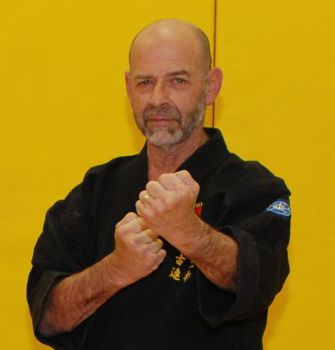Kamae (構え)
 Kamae (構え) translates approximately to “posture” or “combat posture”. The Kanji of this word means “base”.
Kamae (構え) translates approximately to “posture” or “combat posture”. The Kanji of this word means “base”.
As a practitioner of the martial arts for over 50 years and a student of Master Kise’s and Kaicho’s for over 30 years, I would offer my humble opinion on this subject.
IMHO, the use of a Kamae or a posture has been around for a very long time. The very early hunters and gatherers learned postures involving how to stand or crawl in order to eat. The very ancient systems of Chinese Qigong, as well as other ancient cultures, placed an emphasis on certain postures, along with proper breathing and mental focus for increased health. Whether you are learning the proper way of standing or moving for health or for combat, the posture or kamae plays an important part.
Posturing or the use of kamae are used in the animal kingdom all the time, and it would make sense that martial arts systems that have their roots on Shamanism would adapt this into their arsenal. Two basic strategies that are used include showing more strength than there really is or showing a potential weakness where there really is none. Showing more strength is seen in a blowfish that makes himself appear larger to keep other animals from attacking or even here in Colorado when you walk up on a mountain lion or bear by making yourself appear as large as possible and slowly walking away but never running.
Showing an opening or opportunity can be seen when a bird fakes a broken wing to pull a predator away from her young or even in the drunken fist styles of Chinese martial arts where the opponent gets overconfident only to be hammered by a proficient attack. Either strategy can be used to catch your opponent off guard as mentioned in Sun Tzu’s Art of War or even the Japanese classic of the Five Rings.
 An individual can use these postures when he practices his personal tactics of self-defense like doing kata or even in group tactics such as troop movements. We have known for centuries how to show a weakness in order to bring in the enemy from a certain direction only to attack from the flank to eliminate the threat. We also know that showing strength decreases the chance that an opponent will attack in that specific area. This strategy is used throughout classical Okinawan and Chinese forms.
An individual can use these postures when he practices his personal tactics of self-defense like doing kata or even in group tactics such as troop movements. We have known for centuries how to show a weakness in order to bring in the enemy from a certain direction only to attack from the flank to eliminate the threat. We also know that showing strength decreases the chance that an opponent will attack in that specific area. This strategy is used throughout classical Okinawan and Chinese forms.
Learning classical kata includes training in many different areas and at different levels. Learning the kicking and punching is only as good as the grounding, centering, footwork and body shifting that goes with it. Learning how to predict the opponents next move through the use of kamae and having the best response ready to go is a high-level tactic and IMHO, a very important part of classical training and martial arts mastery.

